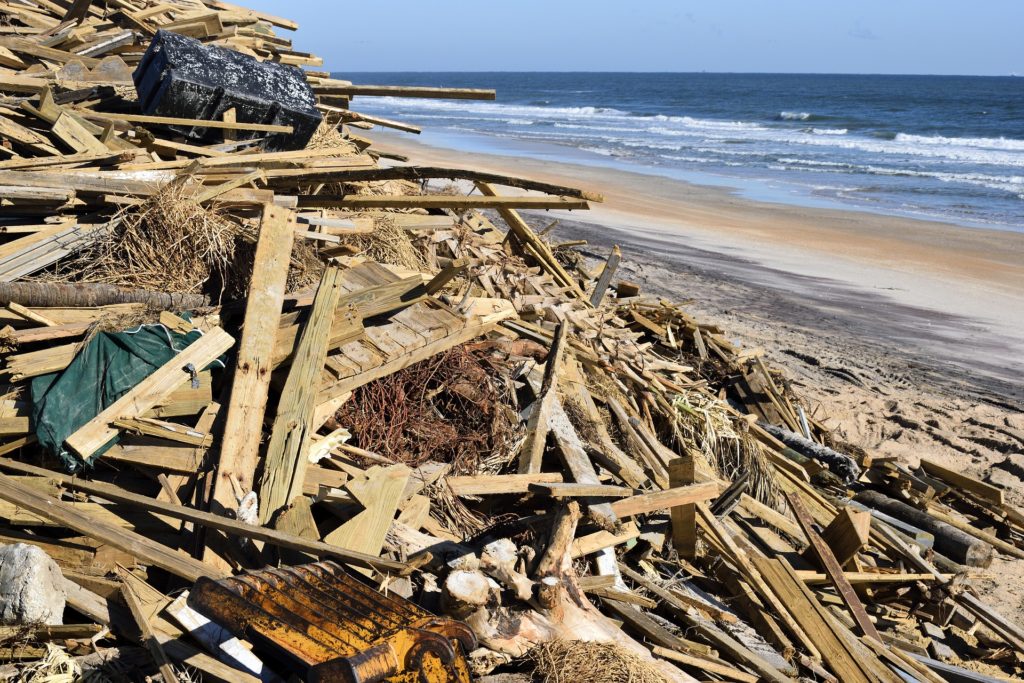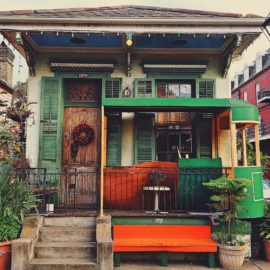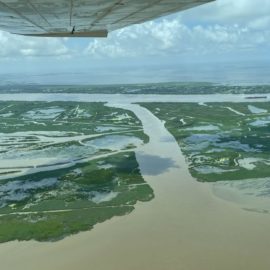
It is hurricane season and in many places hit hard these past two years there is still work to be done.
Hurricane Ida tore off Cherie Matherne’s roof and dug out her home’s insides, scattering her family’s possessions and leaving bedroom doors and kitchen cabinets piled on her rain-soaked floors. Nine months later, Matherne and most of the other members of the Pointe-au-Chien Indian Tribal Community are still unable to move back into their storm-ravaged homes. All but a dozen of the 80 tribal households in the small coastal community of Pointe-aux-Chenes, which is spelled differently than the tribe, are living in trailers, tents and other temporary accommodations alongside houses in various states of wreckage and repair. Many members are waiting for housing assistance, resolutions to insurance claims or contractors too busy to call back. “There’s a lot of stress and anxiety right now,” said Matherne, the tribe’s cultural heritage and resilience coordinator. “There’s so much work that needs to be done in the area. Everybody has to wait but we can’t wait forever.”
nola.com
It is mostly the lower parishes closer to the Gulf where the storm surge was the worst.
Thousands of others in the hardest-hit parishes — Terrebonne, Lafourche, St. John the Baptist, St. Charles and lower Jefferson — are facing similar challenges, and time may be quickly running out. This year’s hurricane season began Wednesday and runs until Nov. 30. The National Oceanic and Atmospheric Administration is predicting a seventh year in a row of above-average storm activity, including 3-6 major hurricanes of Category 3 or greater. “Ida’s winds tore us up,” Windell Curole, manager of the South Lafourche Levee District, said of the Category 4 storm. “Things are getting a little better. The blue (tarped) roofs are going away, but seeing some people still living in tents is very depressing.” And dangerous. Tents and trailers won’t hold up to storms the way wood and brick homes do. “The mobile homes and FEMA trailers — they will totally disintegrate,” Terrebonne Parish President Gordy Dove said. “And we have 4,000 people living in them right now. A big hurdle for us will be to get all the people out of them before the next hurricane.”
Many have been approved for FEMA help but a sizeable number are still waiting for this help.
FEMA has approved more than 95,000 households for Ida-related housing assistance in Terrebonne, Lafourche, St. John, St. Charles and Jefferson parishes. Jefferson, which includes the devastated towns of Grand Isle and Jean Lafitte, accounts for about half, followed by Terrebonne with 18,000 households approved for assistance, which includes money for house repairs or temporary rentals. Of the 3,460 households that have been approved for FEMA trailers and mobile homes in the five parishes, about a third still have not received them. FEMA officials say procuring thousands of trailers and mobile homes takes time. Most hurricane victims want their temporary housing alongside their damaged homes, but that involves hauling temporary structures to hundreds of different locations, many of which may be cluttered with storm debris or require complicated property use negotiations and utility hookups.
Part of the problem is that FEMA does not make you well, they just put a roof over you head.
FEMA’s “direct housing” program “is neither an immediate solution nor a permanent solution for survivors’ interim and longer-term housing needs,” FEMA said in a statement. “The program may take a significant time to implement. That’s why it is not among the first options we employ in a disaster recovery.” The state, parishes and nonprofit groups are trying to fill the gap in temporary housing. Near a truck stop casino just outside Houma, a veritable town of trailers has taken shape in recent months. Managed by the state, the collection of at least 280 trailers at what’s known as the old Rebecca Plantation is the biggest in Terrebonne. “This trailer, it’s a blessing from God,” said Kent Portier, a retired oil worker who moved into his 28-footer five months ago. Portier was evicted from his Houma apartment after it became unlivable from storm damage. The 65-year-old then bounced around shelters in Houma and Morgan City for three months. He hoped to reunite with his fiancee, who also lost her apartment, but she died from compounding health issues just before he acquired his new home in late December. “This was supposed to be our place together,” he said, showing off the trailer’s kitchen and two bedrooms. He isn’t sure where he’ll go next, but he knows he won’t survive even a small storm in the wobbly aluminum structure. “Oh, heck no, I can’t stay here,” he said. “We get a serious wind here and this thing is rockin’ and rollin’. There are no tie-downs; nothing holding it. Even in the lightest storm, this’d be flip-flopping.”
Some make the temporary housing pretty but flowers won’t make the storm do less damage.
A few rows down, the Marcel family appeared to be putting down roots. Their trailer’s space was crowded with about 60 potted plants. Roses and hibiscus bloomed near the trailer door and a trellis of fragrant jasmine hovered over a wicker rocking chair. For Lori Marcel, the garden is a refuge from life inside the trailer, where she and her husband, Rhett, have been raising five kids for almost six months. “I try to make it a blessing for people’s eyes,” Lori said. “Things are hard. At least we can have that.” Rhett, bleary-eyed and smoking a cigarette down to the filter, would like one decent night’s sleep. With just 42 square feet per person, the family has to sleep in shifts on the beds as well as the floor and kitchen table. “Can’t get no sleep ‘cuz there’s no place to sleep,” said Rhett, who lost his shipyard job during the coronavirus pandemic and his mobile home during Ida. With so many buildings damaged, the rental market’s tight and prices are rising, he said. He’s not sure how long they can stay in the FEMA-owned trailer. “Depends on who you ask,” he said.
FEMA extended the time they could stay in the trailers but where will they go?
FEMA recently extended the use of some trailers and mobile homes until March, but residents are urged at least once a month to make other plans. Despite the housing troubles, Terrebonne and Lafourche residents don’t appear to be abandoning their parishes. Terrebonne has issued more than 10,000 building permits since Ida. The parish has mounted an ambitious infrastructure rebuilding effort, replacing wooden utility poles with metal, adding pump stations and backup generators and moving forward with plans to replace the parish power plant, destroyed by Ida. In Pointe-aux-Chenes, few have opted to move away after Ida. “We’re a fishing community,” said Theresa Dardar, a tribal leader whose husband is a crabber. “We can’t leave. Even the people who retired from fishing, they still want to be here, no matter what.” Dardar’s mother-in-law, Nazia Dardar, isn’t budging. The 88-year-old Francophone who speaks only rudimentary English has known no other place than Pointe-aux-Chenes. Sitting on a rocking chair overlooking the bayou, she expressed absolute faith that her 15 children, the youngest of whom is 49, will keep her safe and again replace her roof if the new one just installed is torn off. “I didn’t ever see a storm like that,” she said of Ida. “But all my family is here, so I will stay.”
People may not be leaving but the tone of the community has changed, as they said about New Orleans after Katrina.
People may not be abandoning hard-hit areas, but the character of some communities have undergone dramatic and possibly permanent change. On Grand Isle, where about 700 buildings were destroyed by Ida, beachgoers and anglers are returning and vacation homes are being rebuilt, but school enrollment has fallen from 150 students to about 65, said Jefferson Parish Councilmember Ricky Templet, whose wife, Christine, is the principal of Grand Isle School. In Jean Lafitte, the two schools remain closed due to severe flood damage. Many Lafitte students spent the year squeezed into schools in Marrero and other parts of the West Bank, Templet said. The effort to revive Pointe-aux-Chenes’ long-shuttered school was derailed after Ida tossed a section of the building into the middle of a road. Pointe-aux-Chenes also lost its only store, which sold groceries, fishing gear and tools, and was renowned for the king cakes from its backroom bakery. The Pointe-au-Chien tribal center is now stocking donated food and toiletries. The community’s fire station looks much like it did when Ida ripped off its roof and bay doors. Emergency responders now come from Montegut, about 11 miles away. Matherne said it took an alarmingly long time for firefighters to get to a recent oyster plant fire in lower Pointe-aux-Chenes. “I don’t know what we’re going to do if someone gets sick or there’s some other medical emergency,” she said. “It feels like we’re on our own.”
Their problem are compounded as there are gaps in the levees that are supposed to be protecting them.
Amplifying the anxiety in Pointe-aux-Chenes is the fact that the community sits near a two-mile-wide gap in the nearly 100-mile Morganza-to-the-Gulf hurricane levee. In the works since 1993, the Morganza project has been built by the Terrebonne and Lafourche parish levee districts using state and federal money totaling more than $1 billion. It’s designed with a so-called 100-year level of protection — high enough to not be overtopped by surges caused by hurricanes with a 1% chance of occurring in any year. Last year, the federal government approved a long-awaited 65% federal share of the project’s $3 billion total cost. Levee managers say the gap near Pointe-aux-Chenes will be filled soon, but not this hurricane season. It’s not lost on Matherne that the last bit of undone levee sits alongside a Native American community. But that’s par for the course for the tribe, which Matherne said is often a low priority for parish services. “After (Ida), we didn’t see parish officials down here,” she said. “Tribal members had to clear the roads and make sure everyone was OK.” The historically Native American community on nearby Isle de Jean Charles was left out of the Morganza project and has only small levees protecting it. The majority of the homes of full-time Isle de Jean Charles residents were destroyed or severely damaged by Ida.
Those communities that straddle two parishes lines are in worse shape as which one provides help?
Because Pointe-aux-Chenes straddles the border between Terrebonne and Lafourche, parish governments often disagree over who should take care of it. Curole, the Lafourche levee manager, agreed that Pointe-aux-Chenes sometimes suffers when the parishes don’t work well together. “It’s true, but getting three levee districts and two parishes to agree on something isn’t always easy,” he said. “Because the area’s between us and doesn’t have a real big population, it took a while to get improvements, but we’re getting there.”
The Corps is planning work but when?
Had Ida’s eye had passed a bit to the west, the bulk of the storm surge might have pushed into the gap and flooded Pointe-aux-Chenes rather than Lafitte, which experienced some of the hurricane’s worst flooding. Pointe-aux-Chenes isn’t the only coastal community with incomplete defenses. Ida punched through Grand Isle’s levee in 12 spots, allowing storm surge to sweep over much of the island. Sandbags still sit in the gaps, giving residents little comfort ahead of this year’s hurricane season. “Those bags will wash out very easily,” Templet said. “We don’t want the island cut in half, but that could happen even with a Category 1 (hurricane).” The Army Corps of Engineers is planning a $122 million rebuild of the Grand Isle levee, but work won’t begin until August and likely won’t be finished until late this year. Crews were building the last section of the Morganza project this week, but work was progressing from the Lafourche side near Cut Off, several miles from Pointe-aux-Chenes. Even when finished, the levee near Pointe-aux-Chenes will stand only 8 to 10 feet high, unlike the rest of the project’s levees that reach 12 feet. In 2019, Hurricane Barry, a Category 1 storm, easily overtopped 8-foot-high levees in nearby Montegut and Dularge and flooded Pointe-aux-Chenes. “That’s why we always worry,” Matherne said. “The protection just is not there for us.”
There is work to be done but time may not be in their favor.



